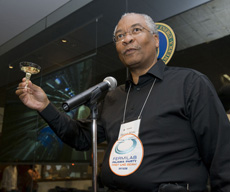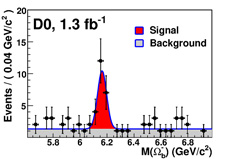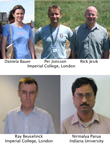|
Thursday, Sept. 11
THERE WILL BE NO PHYSICS AND DETECTOR SEMINAR THIS WEEK
2:30 p.m.
Theoretical Physics Seminar - Curia II
Speaker: I. Low, Northwestern University/Argonne National Laboratory
Title: Kaluza-Klein Parity in Warped Extra Dimensions
3:30 p.m.
DIRECTOR'S COFFEE BREAK - 2nd Flr X-Over
THERE WILL BE NO ACCELERATOR PHYSICS AND TECHNOLOGY SEMINAR TODAY
Friday, Sept. 12
3:30 p.m.
DIRECTOR'S COFFEE BREAK - 2nd Flr X-Over
4 p.m.
Joint Experimental-Theoretical Physics Seminar - One West
Speaker: S. Söldner-Rembold, University of Manchester
Title: Double Beta Decay Searches with NEMO-3 and SuperNEMO
8 p.m.
Fermilab Lecture Series - Auditorium
Tickets: $5
Speaker: Dr. Victor Baker, University of Arizona
Title: Megafloods
Click here for NALCAL,
a weekly calendar with links to additional information. |
|
Thursday, Sept. 11
- Santa Fe black bean
- Steak tacos
- Chicken Wellington
- *Smart cuisine: spinach enchiladas
- Baked ham & Swiss on a Ciabatta roll
- Assorted slice pizza
- Crispy fried chicken ranch salad
*Carb restricted alternative
Wilson Hall Cafe menu |
|
Thursday, Sept. 11
Dinner
- Closed
Wednesday, Sept. 17
Lunch
- Pork satay w/peanut sauce
- Jasmine rice
- Coconut cake w/ rum caramel sauce
Chez Leon menu
Call x4598 to make your reservation. |
|
|
Fermilab crowd joins CERN live to celebrate LHC startup

LHC First-beam Pajama Party emcee Herman White toasts the startup of the LHC.
Roughly 400 people gave up sleep early Wednesday to become part of history and watch the launch of the high-energy physics machine expected to change our knowledge of the universe.
Addressing the Fermilab crowd via video conference, CERN Director General Robert Aymar thanked the people at Fermilab for their help over the years.
Through the Department of Energy and the National Science Foundation, the U.S. contributed $531 million to the LHC construction and hosts about 2,000 of the 6,000 scientists worldwide working on the LHC experiments. About 100 U.S. universities contribute to the LHC experiments, including hardware, computing and data analysis.
Aymar praised the Japanese-and American-made equipment that, he said, worked without difficulty on the first 17-mile clockwise trip of the beam of the Large Hadron Collider at CERN.
In less than an hour, a team of accelerator experts managed to send the first beam all the way around the 17-mile LHC ring.
Read more
--Tona Kunz
|
Scientists beaming after test of big atom smasher
From Associated Press, Sept. 10, 2008
A small blip on a computer screen sent champagne corks popping among physicists in Switzerland. Near Chicago, researchers at a "pajama party" who watched via satellite let out an early morning cheer.
The blip was literally of cosmic proportions, representing a new tool to probe the birth of the universe.
Read more
|
Scientists Activate Particle Collider
From The New York Times, Sept. 10, 2008
Science rode a beam of subatomic particles and a river of champagne into the future on Wednesday.
… An ocean away from Geneva, the L.H.C.’s activation was watched with bittersweet excitement here at the Fermi National Accelerator Laboratory, or Fermilab, which until that moment had the reigning particle collider.
Some 400 students and onlookers, and three local mayors, gathered overnight to watch the dawn of a new generation in high-energy physics, applauding each milestone of the night as the scientists slowly steered the protons on their course at CERN, the European Organization for Nuclear Research.
Many of them, including the lab’s director, Pier Oddone, were wearing pajamas or bathrobes or even night caps bearing Fermilab "Pajama Party" patches on them.
Read more
|
Inside LHC Launch Party, Not End of World
From Popular Mechanics, Sept. 10, 2008
Want to see the Large Hadron Collider's first proton beam race through an underground loop at a blistering 185,000 miles per second? Don't blink.
Some 400 physicists, engineers and students just finished camping out here at the Fermi National Accelerator Laboratory through the night, awaiting the birth of an extreme machine so powerful that it could soon reveal what lent mass to the universe in the first place. At around 2:34 a.m., a fuzzy white ball appeared on a projection screen outside Fermilab’s Remote Operations Center amid a sea of gray, framed by what looked like a rifle scope.
Read more
|
Fermilab celebrates CERN collider test
From Beacon News, Sept. 10, 2008
At 1:30 on Wednesday morning, Fermilab was the hottest ticket in town. But only if you had a pair of stylish pajamas.
That's where a couple hundred of the smartest people you could ever hope to meet gathered together, bleary-eyed but excited, to watch a live feed from Switzerland as the Large Hadron Collider, now the biggest particle accelerator in the world, took its first test flight.
Read more
Editor's Note: Reporter Andre Salles, Beacon News, also produced this video of the pajama party.
|
|
|
A strange, strange relative

This figure illustrates the invariant mass of Ωb- events observed in J/ Ψ and Ω- decays. The signal contribution (red) is shown along with the expected background (grey) and the observed data.
Everyone's got one or two in their family. It could be your delightfully
eccentric, cat-loving aunt or your Star Trek-fanatic cousin. Either way,
they're never the first relative you want to introduce to a new friend.
This is exactly what happened with the proton. For more than four decades, physicists have suspected that the proton has a rather large extended family, but have had few opportunities to meet many of its relatives. Scientists at Fermilab's DZero experiment have just been closely introduced to a strange and somewhat reclusive member of the proton's family, who will hopefully mark a new phase in our understanding of matter.
The proton belongs to a family of particles known as baryons, which are
composed of three quarks. The proton contains two up quarks and a down quark.
Theory predicts that, along with the bottom and strange quarks, there are 20 ways
to mix these four quarks to form baryons with one-half unit of spin (a quantum
mechanical property related to angular momentum). Of these 20, three are very
"strange" and contain two strange quarks along with one other quark. Two of
these, the Ξ- and Ξ 0, are well-known to physicists. But the third, the doubly strange b baryon Ωb- (made of a bottom and two strange quarks), has until now been kept shut away from the curious eyes of the proton's physicist friends.
Using 1.3 inverse femtobarns of data, DZero researchers have reported
the discovery of the Ωb- baryon with a
measured mass of 6165 ± 10 (stat) ± 13 (syst)
MeV/c2. With roughly 18 events carrying the signature of
Ωb- decays to lighter particles, the
observation has a significance of 5.4 sigmas or a one in 15 billion
chance of coming from non-Ωb- sources.
This discovery provides new data for theorists trying to understand
complex quark interactions and arrives closely behind DZero's discovery
of the Ξ b- baryon in 2007. With this closer look at the proton's extended family, DZero scientists are eager to learn more. Now that some of the strangest relatives have been introduced, the record luminosity delivered daily by the Tevatron may be all that's needed to break the ice with the remaining family.
 |
A group of DZero collaborators made primary contributions to this analysis. Not pictured: Yuriy Merekov of the Joint Institute of Nuclear Research (JINR), Russia. |
| The algorithms used to preferentially select interesting events in DZero's level 3 trigger play a key role for analyses, such as the one shown here. Rick Jesik, Per Johnson and Daniela Bauer are the current and recent level 3 group conveners; Ray Beuselinck made major contributions to the trigger tracking algorithms and Nirmalya Parua to the certification of the level 3 code. |
 |
|
|
Have a safe day!
Megafloods lecture Sept. 12
Megafloods are the largest known freshwater floods with flows comparable in scale to ocean currents. They are capable of inducing global changes in climate. Fermilab Lecture Series will present a lecture on these floods by Dr. Victor Baker from the University of Arizona on Friday, Sept. 12, at 8 p.m. Tickets are $5. More information.
September Wilson Hall Window washing
Window washing of Wilson Hall's exterior windows will continue through Friday. Please clear all items from in front of windows prior to your floor's interior washing date.
Thursday: Ground, Mezannine and floors 1-3.
Oct. Microsoft Word, Excel classes offered
The Office for Professional and Organization Development will offer classes in Microsoft Word and Excel in early October. "Word 2003 Advanced" will take place on Oct. 7. Learn more and enroll.
"Excel Advanced" will take place on Oct. 8. Learn more and enroll.
International Folk Dancing Thursday
International Folk Dancing will take place in the Kuhn Village Barn on Thursday, Sept. 11. Dancing begins at 7:30 p.m. with teaching and children's dances earlier in the evening and request dancing later. For more information, call (630) 584-0825 or (630) 840-8194 or e-mail folkdance@fnal.gov.
Additional Activities
|
|